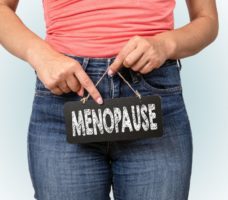By: Rachel Daof
Los Angeles PHRC members, Stephanie Prendergast, Courtney Edgecomb, and I, Rachel Daof, went to a dinner to discuss Intrarosa with guest speaker Dr. Irwin Goldstein. One of the major points of the night was this: menopause is a chronic progressive, degenerative condition, and it does not improve without treatment. This hit home to all of the women in the room because we all were, are, or are going to experience this milestone in life. Menopause is when a woman does not have a period for 12 consecutive months by the depletion of ovarian follicles/oocytes.1 Consequently, women will have a significant decrease in reproductive hormones, which is essential to keeping the genitourinary area healthy and symptom free. The conversation progressed to what the genitourinary region would look like once a woman has gone through menopause. It was answered: genitourinary syndrome of menopause (GSM) would occur.
1. What is GSM?2
GSM affects the labia majora and minora, vestibule (vaginal entrance), clitoris, vagina, urethra, and bladder. As reported by Simon, the changes include a “[reduction] in collagen and elastin, thinning of epithelium, altered function of smooth muscle, loss of elasticity and flexibility, and diminished blood supply” to the above regions. As a result, the signs and symptoms of GSM include, but are not limited to, the following:
2. Genitourinary structures require both estrogen and androgens
The first thing you should know about genitourinary health regarding this topic is that the ovaries and the adrenal glands are the main suppliers of female sex hormones. It is important to note that all androgen sex steroid hormones are as important as mere estrogen to maintain genitourinary health. These androgens include: “DHEA, androstenedione, androstenediol, testosterone, and 5α-dihydrotestosterone (5α-DHT), . . . [and] androgen receptors are widespread throughout the genitourinary tract (clitoris, vestibule, urethra, bladder, vagina, female prostate tissue).”2 Premenopausal women produce a significantly greater amount of androgens than estrogen alone, and androgens are able to biosynthesize into estrogens. View the following chart for more detailed information:
(Traish)3
As you can see in the chart above, DHEA is the main androgen secreted by the adrenal glands to then synthesize other sex hormones. At about 30 years old, your body starts to have a natural decline of DHEA; however, it is still available. The thing about menopause is that you don’t get these much needed hormones from your ovaries anymore, and you rely solely on DHEA, which has already declined about 60%. Therefore, signs and symptoms of androgen and estrogen decline will parallel the decline of DHEA because it is the main source that is left supplying the vulvovaginal region of necessary hormones.2 To beat a dead horse, you need androgens for genitourinary health.
Circling back to menopause, the genitourinary system is greatly impacted when there is a decrease in estrogen and androgens. Many women are currently using just estrogen to combat menopausal symptoms, but we now know that doesn’t suffice. Prior to 1942, it was commonplace to be treated with ovarian extracts which contain both estrogen and androgens. It is time we start looking at both estrogen and androgens again to combat GSM.
3. Diagnosis of GSM2
If you suspect that you have GSM, it is time to go to a skilled health care professional to confirm a diagnosis. Confirmation will include:
4. Treatment of GSM
Intravaginal DHEA (prasterone, the active ingredient in Intrarosa) has been approved by the FDA for the management of moderate to severe dyspareunia due to menopause. After intravaginal DHEA is placed, it is then converted by enzymes within the vagina via intracrine metabolism to then produce estrogens and androgens (androstenediol, androstenedione, testosterone, and DHT). This means that the DHEA that is placed intravaginally will not be taken up systemically, and it stays within the genitourinary region. DHEA is inactive until it is “transformed inside the cells into cell-specific amounts of estrogens and androgens.” This means, only “inactive metabolites” are in circulation which “eliminates the risk of an influence in other tissues. This treats the tissues locally while having the rest of the body maintain normal levels of sex steroids. “DHEA only replaces what is missing at the right place and in the right amount.”2 It stays inactive in your system until your body needs it, so you do not go over normal levels of DHEA. What it is mainly prescribed for is pain for postmenopausal women, and it is a vaginal insert. If you are experiencing pain with intercourse after menopause, please visit Intrarosa’s website here and talk to your medical provider for a prescription.
Compounded topical estrogen and testosterone has also been used for vestibulodynia in premenopausal women with great success, but there is lacking research with postmenopausal women. For more information on premenopausal vestibulodynia and oral contraceptives, please look into this blog (and part two) written by Dr. Joshua Gonzalez.
The symptoms women experience in menopause such as painful sex, urinary urgency/frequency, and vulvar pain are also symptoms of pelvic floor dysfunction. If you are experiencing these symptoms a combination of medical management and pelvic floor physical therapy can help! Check out our website and our book, Pelvic Pain Explained, for more information.
References:
This content was originally published here.















